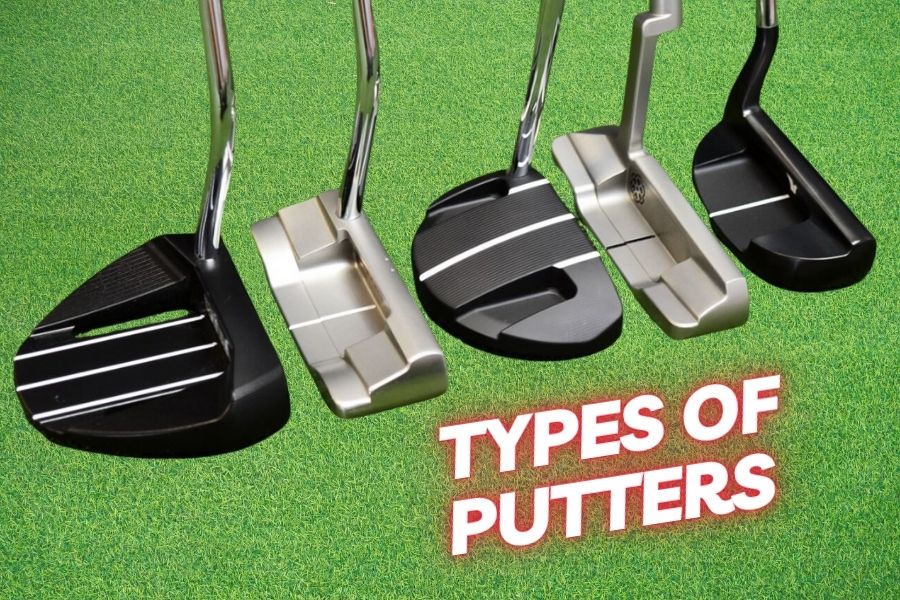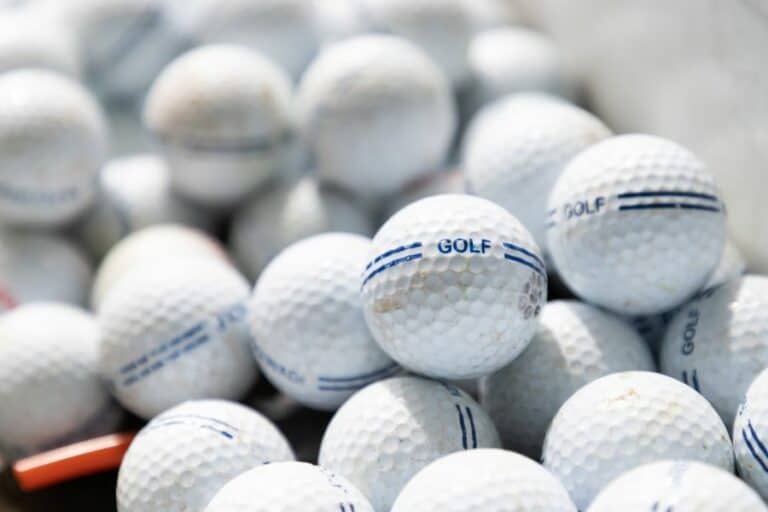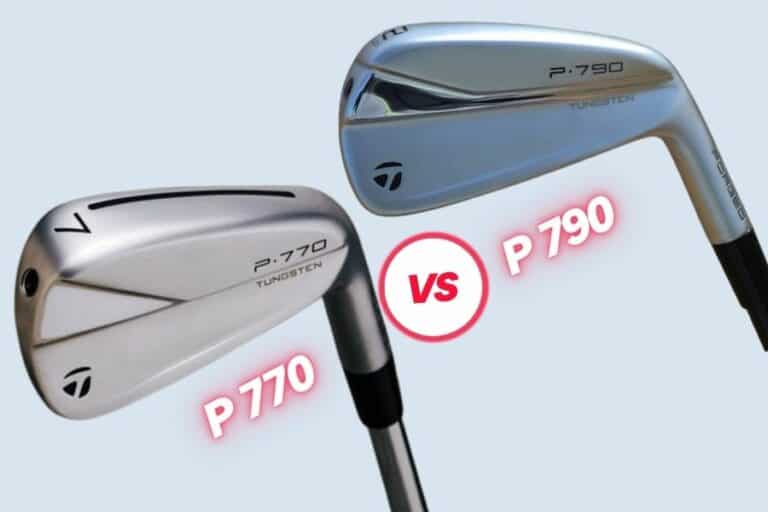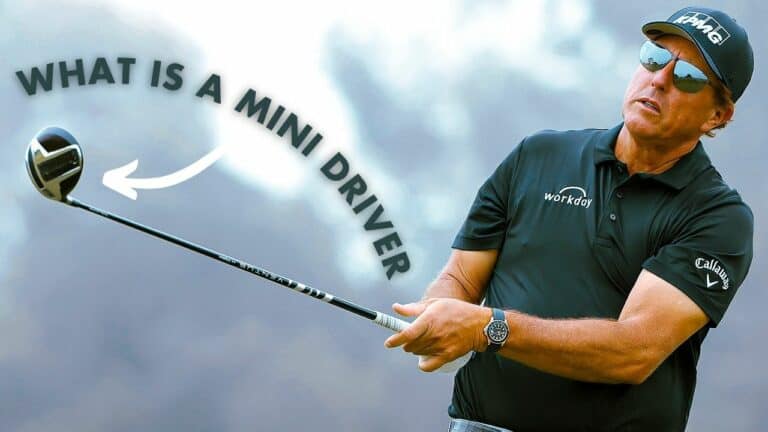Types Of Putters And How to Choose One: The Complete Guide

The variety of putters available in the market may overwhelm you. Thus, for your ease, this article puts together details about some of the most important putters you must know.
Your putting stroke can make or break your game. When it comes to putters, there are a variety of types and styles available. You need to know the different putter types to choose the right one.
Types of putter heads
The type of putter head you choose can make a huge difference in the consistency of your swings and determine how accurately you can hit your golf balls straight. Here are two broad types of putters:
1. Blade putters
These are the most traditional and classic type of putters, characterized by their flat, small, and rectangular heads.
These are the most common type of putters and the simplest in terms of design, as they are usually made of stainless steel and have a simple, blade-like appearance. The blade putter is a favorite among many golfers due to its straightforward design and reliable performance.
Being lightweight, these putters have a great feel making them popular among players who prefer to control the line their ball starts on.
They are also face-balanced, which makes them perfect for golfers with a straight-hitting stroke.
Additionally, these putters offer remarkable accuracy on more demanding greens that require a deft hand and touch.
2. Mallet putters
Mallet putter designs vary, but all commonly feature adding weight around the perimeter for greater stability.
This type of putter features a larger, more rounded head shape than blade putters.
They are some of the most stable and forgiving putters due to their heavier weight and deep head design giving them a deep center of gravity.
Mallet putters are very popular among mid-handicap golfers looking for accuracy, better performance on longer putts, and consistency on the green. This help improves performance on off-center hits.
Moreover, the various alignment aids and shapes on the head are good for players with an arced stroke.
Read More: Mallet vs Blade Putter
3. Heel -Toe Weighted Putters (Peripheral Weighted)
The heel-toe putters are also known as Peripheral weighted putters. These clubs have a long and thin toe.
However, adding additional weight to the toe and heel region could give more consistency and forgiveness.
These putters usually feature extra weight on the head’s perimeter, which helps the club produce a higher moment of inertia and reduces the chances of twisting at impact due to off-center hits.
Types Of Balance
Putters come in a variety of balances, each offering different benefits and performance characteristics. The three main types of balance are face-balanced and toe-balanced.
1. Face-Balanced Putters
Face-balanced putters are designed in such a way that the face of the club is facing upwards when the shaft is balanced on your hand.
Most mallet putters are face-balanced putters and have the weight spread evenly across the putter.
Consequently, this ensures an ideal center of gravity directly underneath the axis of the shaft for maximum accuracy and precision with every swing.
Golfers with a straight putting stroke are likely to work well with a face-balanced putter as it opens less on the backswing and closes less on the follow-through.
2. Toe-Balanced Putters
The toe-balanced putter has the shaft placed closer to the toe section of the head, often known as a “toe-hang putter.”
The center of gravity of these putters is not directly beneath the shaft.
Contrary to the face-balanced putters, the toe of this putter will sink and point downwards when balanced horizontally across your palm.
This is meant for golfers with an arced putting stroke, who need more forgiveness as it will open on the backswing and close on the follow-through.
It also helps players control their speed better since it requires a smooth tempo throughout the stroke.
3. Counterbalanced Putters
Counterbalanced putters feature extra weight in the shaft and grip section of the club.
Thus, they are also known as “heavy” putters. It usually weighs more than 50gm. Generally, manufacturers do this by increasing the putter shaft length.
This helps shift the center of gravity further away from the hands, allowing players to generate more power and control their stroke through impact for a more consistent roll.
Types of putter faces and Inserts
The putter face is the most important element of a putter, as it affects the speed and direction of your ball.
1. Metal-faced putters
They are characterized by a clubface made of metal, typically steel, zinc, aluminum, brass, or titanium. Metal-faced putters are often chosen for their durability and low maintenance, as the metal clubface is resistant to wear and tear and does not require frequent regrooving.
It is a good choice for those who want a controlled yet firm feel off the face.
Moreover, a metal-faced putter produces a loud sound when it makes contact with a golf ball. This helps you understand the connection you made and to ascertain the putter’s center.
However, some metal putters have milling on its face, making them feel and sound softer as there is less material to make contact with the ball.
2. Insert-faced putters
The insert-faced putters are characterized by a clubface with a soft, synthetic design.
This improves the feel and feedback on putts.
Insert-faced putters are often made of lightweight materials such as aluminum or rubber, which helps keep the club’s overall weight down.
Since they have a soft feel, they are great when used with firm-cover balls.
3. Groove-faced putters
A groove-faced putter has grooves in it. It can be either insert-faced or metal-faced. The grooves work to grip the ball and lift it when your putter makes contact.
A grooved putter can help achieve a forward rolling motion on the ball after it is hit. This motion is required for precise putting.
The grooved putter grips the ball’s surface, lifts it out of its resting position, and rolls it out to the hole.
The grooves or other textured features on the clubface can help to reduce skidding and promote a more consistent, smooth roll of the ball.
This can be particularly beneficial for players who struggle with getting the ball to roll on the intended line or who have difficulty with distance control on putts.
Insert putters vs. Milled putters
The table below compares the differences between insert putters and milled putters based on various factors:
| Feature | Milled Putter | Insert Putter |
| Construction | Made from a single piece of material, often a soft metal, and milled into shape with no added components | Has an insert in the putter face that significantly impacts how the putter feels and performs at impact. |
| Feel | Has a more high-end feel, stable, and consistent at impact | Almost always has a softer feel, which is a good option if you want a very soft feel when putting. |
| Performance | Offers consistent performance for years to come | Poor engineering can cause poor performance when missing the center of the face and may experience issues with the insert falling out over time. |
| Price | Expensive | Can be cheaper, but if buying an insert putter, it is recommended to spend at least $100 to avoid poor engineering and potential issues with the insert. |
Length of Putter
Putting is a crucial part of any golfer’s game, and the length of a putter can have a significant impact on one’s performance on the green. Here are the details of length of different types of putters every golfer must know:
1) Traditional Length Putter (Standard Length Putter)
The majority of golfers typically utilize traditional length putters. They provide for a comfortable, pendulum-like putting stroke and are often shorter in length, ranging from 32 to 36 inches.
These putters are readily accessible and can fit players of different heights. Golfers typically utilize a standard-length putter unless they have certain preferences or physical limitations that call for a different style of putter.
2) Belly Putter
Belly putters are longer golf clubs that allow players to anchor the club against their body while putting. The increased stability from the contact point at the player’s torso is the main advantage of using belly putters.
The length of belly putters ranges from 41 to 46 inches.
However, belly putting has been banned from competitive play since 2016, but players can still use belly putters for other styles of putting as long as they don’t anchor the club against their bodies.
When selecting a belly putter, you have the option of choosing from four different shaft types. The shaft type you choose will depend on your putting stroke and preferences.
The four types of belly putter shafts are:
| Belly Putter Shaft Type | Putting Stroke Type | Features |
| Double Bend | Straight-back and through | Offers very little rotation throughout the stroke |
| Short Hosel | Offers very little rotation throughout the stroke | Better suited for players who move inside the line of the putt |
| Plumber Neck | Combination of arc and straight-back | Best choice for putting strokes that combine arc and straight-back |
| Centre Shaft | Straight-back | Usually face-balanced and helpful for straight-back putting strokes |
3) Long Putter
Long putters are the least common type of putter in golf. They are longer than traditional (standard) and belly putters, with lengths ranging from 48 to 52 inches, and are designed to be anchored against the upper torso or chin.
Using a long putter requires a different grip and a unique putting stroke, which is not allowed in tournament play due to the anchoring ban. These putters offer a distinct advantage for players seeking more stability and consistency in their putting game, but their use is limited to non-competitive play.
Putter Construction
In the world of golf club construction, there are two primary methods used:
- Milled
- Cast
Milled putters are crafted by CNC milling a single block of metal, while cast putters are made by combining separately constructed parts. The two techniques result in different characteristics in the club’s design and performance.
Milled Putters
Milled putters are made from a single block of metal, giving them a soft feel and strong structure. The club face has many grooves that give the ball a soft touch.
Milled putters also provide excellent feedback because the club head is solid, making it easy to feel where the club hits the ball.
Milled putters have an attractive look and are commonly used for blade putters. However, it’s difficult to create larger mallet putters using this process. The Scotty Cameron Newport 2 and Ping Anser are classic examples of milled putters.
Cast Putters
Cast putters are built by assembling separate parts together, giving manufacturers more flexibility in design and materials.
Cast putters offer several advantages over milled putters, including the ability to use different materials for the head and club face.
This allows manufacturers to select the best materials for each part of the putter, resulting in improved performance. As a result, cast designs are popular for newer putters, which often have a higher MOI for improved stability and accuracy.
Lie Angle
The angle between the sole and the shaft of a putter is known as the lie, which is usually around 70 degrees. A putter’s lie plays a crucial role in determining its effectiveness. Even a slight deviation of a couple of degrees can have a significant impact on the accuracy of your putts.
When you take your putting stance, the sole of the putter should be resting flat on the green. If the heel or toe of the putter catches the ground during your stroke, it can cause the clubface to turn and twist, leading to inconsistent putting.
Loft
When choosing a putter, many golfers don’t pay attention to the loft of the clubface, which can have a significant impact on their game. A small amount of loft, usually between two to four degrees, can help lift the ball from the green, making it easier to get it rolling on the correct line.
Interestingly, the loft on putters has decreased over the past century due to better maintenance practices, resulting in smoother greens. When you putt, the ball will initially skid for about the first 15% of its journey before the friction of the green starts to make it roll.
Moment of Inertia
The moment of inertia (MOI) is a measure of a putter’s resistance to twisting when the clubface strikes the ball. Higher MOI results in less twisting when the ball is hit away from the center of the clubface.
A putter’s weight also affects its MOI. To increase the MOI, some putter designs redistribute mass from the center of the clubhead to the heel and toe. For instance, the putter shown in the image has been engineered with less mass at the center, and more at the heel and toe.
Sweet Spot
To putt well, it is essential to strike the ball on the sweet spot of the putter’s face. The sweet spot is the area where the ball is most effectively hit and can vary between putters. Some manufacturers may indicate the sweet spot, but if not, players can find it themselves by tapping the face of the putter with a tee or key to hear where the sound is clearest.
Grip
The putter grip is crucial for how the putter feels, with several options available in terms of size, material, and weight. The weight of the grip affects the overall weight of the putter and impacts how the putter feels in the hands. Long grips offer more hand placement options and can redistribute weight, while thicker grips are becoming popular for their ability to reduce wrist movement during the stroke.
Putting Stroke Variations
When it comes to putting strokes, there are various styles to consider. In fact, just like putters, there’s no one-size-fits-all solution. Each player has their own preferences and requirements based on their skills, comfort, and physical attributes.
Three common styles of putting strokes are the High Arc Stroke, Mid Arc Stroke, and Back and Through Stroke.
| Putting Stroke | Other Name | Putter Type Balance |
| High Arc Stroke | Strong arc stroke | Putter with toe hang weighting |
| Mid Arc Stroke | Slight arc or moderate arc stroke | Mid to low toe hang |
| Back and Through Stroke | Straight back or straight through or no arc stroke | Face Balanced |
1) High Arc Stroke
The High Arc Stroke is also referred to as a strong arc. It involves opening the face of the putter in the backswing, bringing it back to square at impact, and then closing it on the follow-through. Golfers such as Ben Hogan, Ben Crenshaw, and Tiger Woods are well-known for using a High Arc Stroke. It is crucial to pair this stroke with a putter with toe hang weighting, which concentrates more of the head weight towards the toe.
2) Mid Arc Stroke
The Mid Arc Stroke, also called a slight arc or moderate arc, is less severe than the High Arc Stroke. It follows the same principle, where the putter face opens in the backswing, comes back to square at impact, and then closes on the follow-through. Pairing this stroke with mid to low-toe hang weighting is advantageous. However, golfers with this stroke can have more putter model options, including blades and mallets.
3) Back and Through Stroke
The Back and Through Stroke is also known as a straight back or no arc stroke. As the name implies, this stroke involves zero arc in both the backswing and follow-through, and the head of the putter stays on the same line throughout the entire stroke. Although many players strive for this style of stroke, different putter models can accommodate different types of strokes. It is advised to pair this stroke with face balanced putter.
Shaft placement
A common factor in selecting the right putter for your game is shaft placement, which can significantly impact your performance on the green.
1. Center-shafted putters
A center-shafted putter connects in the center of the head for a more balanced weight distribution throughout the stroke. This putter is meant for those who prefer to guide their ball toward the hole with a straight putting stroke.
2. Heel-shafted putters
They are characterized by the placement of the shaft on the heel of the putter head.
These putters are mostly meant for golfers with an arced putting stroke. This means that the stroke of the heel-shafted putter curve mimics the “natural putting action.”
3) Hosel Offset Putter
A hosel offset putter is a type of golf club in which the hosel (the part of the club that connects the shaft to the club head) is positioned slightly in front of the club face. This positioning creates an offset between the shaft and the club face, which can help golfers to make more consistent putts by keeping the club head square to the target line. The amount of offset varies between putter models and can range from slight to significant.
How to find the right putter for yourself?
Selecting the right putter can greatly improve your accuracy and consistency on the green. Here are some factors to consider when choosing a putter:
- Head Design: Putter heads come in various designs such as blade, mallet, and hybrid. Blade putters are typically smaller and lighter, while mallet putters are larger and have more weight in the head. Hybrid putters combine elements of both blade and mallet designs.
- Type: There are also different types of putters, including traditional, face-balanced, and toe-balanced. Traditional putters have a slight toe hang and are best suited for golfers who have an arcing putting stroke. Face-balanced putters are best for golfers with a straight-back, straight-through putting stroke. Toe-balanced putters are best for golfers with a pronounced arc in their putting stroke.
- Face and Insert: Putter faces can be made from materials such as steel or aluminum, and some putters also feature inserts made of materials such as polymer or milled steel. Inserts can provide a softer feel and reduce skidding.
- Shaft and Hosel: Putter shafts come in different lengths and materials, such as steel and graphite. Hosel can be either heel-shafted or center-shafted. The type of hosel can affect the putter’s balance and feel.
- Length: The length of the putter should be based on your height, arm length, and posture. A putter that is too short or too long can affect your ability to make consistent strokes.
- Lie Angle: The lie angle of the putter affects the angle of the shaft at impact. A putter with a lie angle that is too upright or too flat can cause the ball to miss the target.
- Loft: The loft of the putter affects the ball’s roll and launch angle. A putter with too much loft can cause the ball to bounce, while a putter with too little loft can cause the ball to skid.
- Moment of Inertia: The moment of inertia (MOI) is a measure of a putter’s resistance to twisting on off-center hits. A putter with a high MOI can help golfers maintain their accuracy on mishits.
- Sweet Spot: The sweet spot is the area on the putter face that produces the most consistent results. A putter with a larger sweet spot can help golfers make more putts.
- Grip: The grip is the part of the putter that you hold onto. Grips come in different materials and shapes, and choosing the right grip can affect your feel and control of the putter.
Conclusion
In conclusion, the types of golf putters available on the market vary greatly. Experimenting with different styles before settling on one that fits your game is best. Ultimately, your choice of the putter should be based on style and feel preferences, as well as your putting stroke type.
FAQs
What putter does Tiger Woods Use?
Tiger Woods, a renowned and accomplished golfer, has been using the Scotty Cameron Newport 2 GSS putter since 2011. This putter has been a critical element of his success on the greens and is the same model that he continues to use to this day.
What differentiates putters?
Choosing the right putter can have a significant impact on your golf game. The look of a putter can affect your confidence, which is essential when making putts. Additionally, the feel of a putter is affected by both its material and design, and can vary from one putter to another. Different putter shapes are also designed to match different natural putting strokes, allowing golfers to find a putter that fits their style and helps them play their best.
What is a better putter – Stainless Steel or Aluminum?
When it comes to selecting a putter, many golfers tend to favor stainless steel or aluminum models. Aluminum is a lighter and more malleable metal, offering a softer feel when hitting short putts. On the other hand, stainless steel putters tend to be more suitable for advanced players looking for greater accuracy on longer putts, even if they may lack the softness in feel that aluminum putters provide. Ultimately, the choice between the two materials depends on personal preference and playing style.
What are the different types of putter shaft?
When it comes to putter shafts, there are 3 main types of putter shaft:
Straight shaft
Single bend
Double bend
The main difference between these types is the number of bends in the shaft. Depending on the overall design of the putter, the shape of the shaft can affect the club’s balance and offset.








